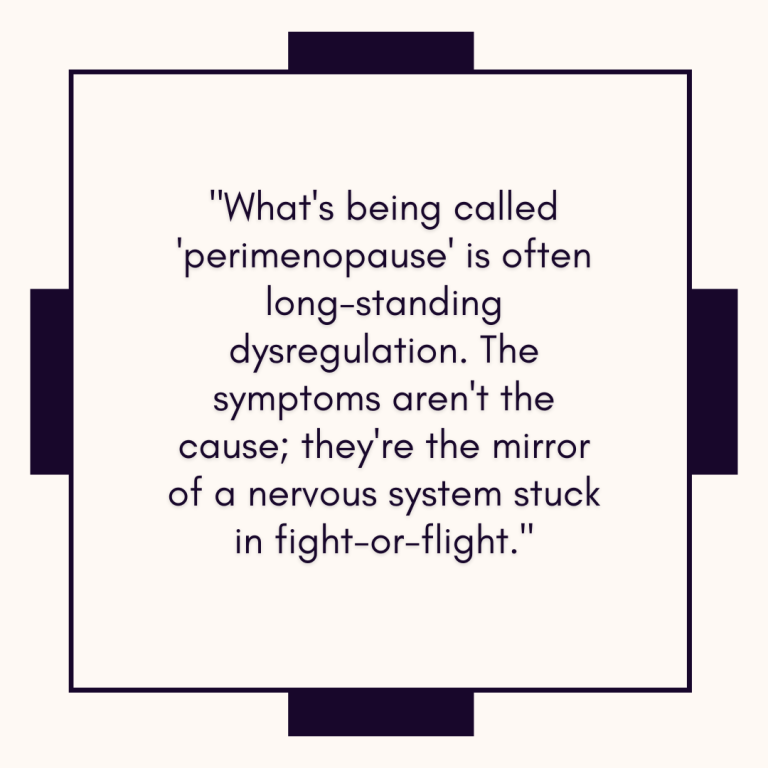Perimenopause Isn’t the Problem — It’s the Mirror


Paige Elizabeth
Founder and Coach
The label women are handed. The roots we’re not fixing.

1. How the “Perimenopause” Label Became a Rug
Once you hit your mid-30s, any shift in mood, sleep, or energy gets labeled perimenopause.
Tired? Perimenopause.
Anxious? Perimenopause.
Can’t lose weight, can’t focus, can’t sleep?
Perimenopause.
We’re finally getting attention — and yet we’re being misdiagnosed.
Because what’s being called “perimenopause” is often long-standing dysregulation that began decades earlier.
What the label hides:
Years of overdrive and sympathetic dominance that the body can no longer bankroll.
Blood sugar volatility from skipping meals, chronic dieting, or low-carb zealotry.
Inflammation and gut burden that quietly distort hormone signaling.
Low fat and cholesterol intake, starving the endocrine system of raw materials.
Poor sleep and circadian chaos that destroy repair cycles.
Emotional overload from unhealed stress, resentment, and hyper-independence.
Reframe: Perimenopause isn’t causing your symptoms. It’s exposing what you’ve ignored.
2. Perimenopause: A Season, Not an Era
Perimenopause is a transitional season, not a 10 or 15-year identity crisis.
It’s the bridge out of fertility, just as puberty was the bridge into it.
When women spend a decade “in perimenopause,” that’s not biology — that’s burnout wearing a hormonal mask.
Like puberty, it’s supposed to be intense but brief.
Symptoms stretching over years point to unresolved metabolic and nervous system stress.
3. Hormones Are the Result, Not the Cause
Your hormones don’t lead the parade — they follow it.
They are mirrors of your nervous system state, nutritional adequacy, and energy availability.
Upstream regulators of your hormones:
Nervous system balance: chronic fight-or-flight exhausts progesterone and blunts ovulation.
Carbohydrate intake: carbs lower cortisol, stabilize blood sugar, and signal “safety.” A chronically low-carb woman is living in chemical alarm.
Dietary fat: cholesterol and fats are the feedstock for every steroid hormone — estrogen, progesterone, cortisol, testosterone. Starve fat, starve hormones.
Protein: structural support and repair, but only when backed by carbs and fats.
Mitochondria: carbs and fats are the dual fuels that power hormone production; flexibility, not restriction, sustains energy.
Mineral balance: sodium, potassium, magnesium, and zinc govern nerve signaling and stress resilience.
Quote: Hormones don’t fail first — energy availability does.
4. The Real Root Causes of “Perimenopausal” Symptoms
| Symptom | Common Root |
|---|---|
| All-day fatigue, wired nights | Adrenal strain, low carb intake, mineral depletion, nervous system overdrive |
| Anxiety, irritability, doom | Blood sugar dips, low magnesium/B6, histamine overload |
| Weight gain around middle | Chronic cortisol, poor sleep, under-eating, muscle loss |
| Hot flashes/night sweats | Blood sugar swings, alcohol, cortisol surges, histamine response |
| Low libido/vaginal dryness | Low thyroid signaling, nutrient depletion, stress dominance |
| Brain fog | Sleep debt, under-fueling, iron/B12 deficiency |
| Heavy or erratic cycles | Inflammation, poor liver/gut estrogen clearance, low progesterone |
None of these are caused by “perimenopause.”
They’re the consequences of a body stuck in fight-or-flight while running on low fuel.
5. The Foundations: Feed the System, Don’t Starve It
Before you chase hormones or labs, you must restore signal safety.
That means eating in a way that tells the body: you are safe to rebuild.
Carbohydrates calm cortisol.
They are your nervous system’s favorite safety signal.
Use fruit, roots, sourdough, rice, potatoes, raw honey.
Include carbs at each meal and especially at dinner to support sleep.
Carbs are not indulgence — they are regulation.
Fat fuels the endocrine engine.
Cholesterol-based hormones rely on dietary fat.
Think butter, avocado, olive oil, ghee, egg yolks, nuts.
Fat anchors your meals and keeps blood sugar stable.
Protein builds structure — but not at the expense of fuel.
Adequate but not excessive.
Balance protein with carbs and fats; otherwise, you push cortisol up and energy down.
Minerals and electrolytes = nervous system currency.
Salt, potassium, magnesium — the triad of calm.
Deficiency here mimics anxiety and fatigue.
Rule: Eat every 3–4 hours. Each meal = carb + fat + protein. No fasting through chaos.
6. Movement, Sleep, and Safety
Strength training: builds muscle and stabilizes glucose.
Walking and restorative movement: regulate the vagus nerve and lymph flow.
Sleep: your body’s hormonal laboratory. 7.5–9 hours minimum; consistent circadian cues.
Down-shifting: breathwork, time in nature, NSDR, body scanning — anything that tells your system it’s safe to digest, repair, and ovulate again.
You cannot supplement your way around a dysregulated nervous system.
7. Smart Testing (When You’re Ready)
Testing is useful only when it guides action.
Start with lifestyle and nourishment; then look under the hood.
Metabolic markers: fasting glucose/insulin, A1c, lipid panel.
Thyroid: TSH, free T3/T4, antibodies.
Nutrients: ferritin, iron panel, B12, folate, vitamin D.
Inflammation: hs-CRP, homocysteine.
Sex hormones: progesterone (mid-luteal), estradiol, testosterone, DHEA-S.
Cortisol rhythm: salivary or DUTCH if chronic fatigue or sleep issues.
Gut testing: if bloating, histamine issues, or food intolerance persist.
8. Restoring Rhythm and Resilience
Phase 1: Stabilize
-
3–4 balanced meals/day: carb + fat + protein.
-
No skipping meals or fasting through stress.
-
Add evening carbs for better sleep and cortisol regulation.
-
Two strength sessions weekly + daily walking.
-
Daily parasympathetic practice.
-
Remove alcohol and stimulants as much as possible.
Phase 2: Rebuild
-
Strength training 3–4x/week.
-
Increase carbs around training and in luteal phase.
-
Add nourishing fats if previously restricted.
-
Support adrenals: pregnenolone, vitamin C, minerals (as guided).
Boundaries as a biochemical intervention — fewer obligations, more recovery.
Phase 3: Refine
-
Adjust food based on energy, sleep, mood, and cycle.
-
Reintroduce favorite foods consciously; watch biofeedback.
-
Consider labs now for deeper fine-tuning.
-
Lock in the new rhythms: nourishment, movement, rest, regulation.
9. Hormone Therapy: Tool, Not Savior
Bioidentical or conventional HRT can be helpful — if your foundations are solid.
But without fuel, sleep, and nervous system regulation, you’ll just create another dependency loop.
Hormones amplify whatever baseline you’re running. Build the baseline first.
10. Red Flags — When to Seek Immediate Medical Support
f you experience:
Heavy bleeding soaking pads/tampons hourly.
New heart palpitations, chest pain, or shortness of breath.
Sudden severe headaches or vision changes.
Unexplained rapid weight loss, fever, or night sweats.
Mood collapse or self-harm thoughts.
Stop reading blogs — go see a clinician.
The Reframe
Perimenopause isn’t a disease. It’s feedback.
It’s your body saying, “I can’t keep living like this.”
When you feed it, rest it, and stop treating stress as strength — your hormones stop screaming.
They recalibrate. They reward you with stability, clarity, and vitality.
This is not decline.
This is integration.Final truth: You don’t fix perimenopause — you listen to it.
Book a Consult: Learn how to fuel your endocrine system and end the survival-mode crash cycle.
